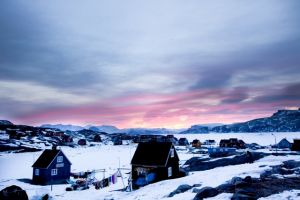Boundary Lines
 Uummannaq village in Greenland (Photo: Grida.no)There are numerous definitions of the Arctic region. The Arctic is generally considered to be north of the Arctic Circle (66° 33´N), which is the approximate limit of the midnight sun and the polar night.
Uummannaq village in Greenland (Photo: Grida.no)There are numerous definitions of the Arctic region. The Arctic is generally considered to be north of the Arctic Circle (66° 33´N), which is the approximate limit of the midnight sun and the polar night.
Other definitions are based on climate and ecology, such as the 10°C (50°F) July isotherm, which roughly corresponds to the tree line, the Tree line itself relating to summer warmth and the AMAP (Arctic Monitoring and Assessment Program) and CAFF (Conservation of Arctic Flaura and Fauna) boundary lines that follow closely the tree line and July isotherm lines.
Following are definitions of the boundary lines, according to the map on the right.
The Arctic Circle
The Arctic Circle is the circle of latitude at 66 degrees 33 minutes N (2606 kilometers/1619 miles from the North Pole) that encloses a northern area of about 8 percent of Earths surface. The Arctic Circle is the southern limit of the midnight sun, where north of the circle there is at least one day each year when the sun does not set at all.
10°C (50°F) July isotherm
This definition means the area where the average temperature for the warmest month (July) is below 10°C / 50°F. Alexander Supan found good coincidence between the tree line and the 10°C (50°F) July isotherm, a figure later modified by Otto Nordenskjöld to allow for spring temperatures.
Tree line
The tree line or timberline is the edge of the habitat at which trees are capable of growing. Beyond the tree line, they are unable to grow because of inappropriate environmental conditions (usually cold temperatures, insufficient air pressure, or lack of moisture). At the tree line, tree growth is often very stunted, with the last trees forming low, densely matted bushes. If it is caused by wind, it is known as krummholz formation, from the German for 'twisted wood'.
The tree line, like many other natural lines (lake boundaries, for example), appears well-defined from a distance, but upon sufficiently close inspection, it is a gradual transition. Trees grow shorter towards the inhospitable climate until they simply stop growing. Extremely cold temperatures can result in freezing of the internal sap of trees. In addition, permafrost in the soil can prevent trees from getting their roots deep enough for the necessary structural support.
Because the climatic zone in which the high-latitude timberline occurs is almost entirely under water in the Southern Hemisphere, this timberline exists only in the Northern Hemisphere. It crosses northern Siberia, Alaska, and Canada, and far-northern Scandinavia.
AMAP line
The Arctic Monitoring and Assessment Programme (AMAP) "area" essentially includes the terrestrial and marine areas north of the Arctic Circle (66°32´N), and north of 62°N in Asia and 60°N in North America, modified to include the marine areas north of the Aleutian chain, Hudson Bay, and parts of the North Atlantic Ocean including the Labrador Sea. Within the AMAP area, 10 "key areas" have been identified that are a special focus for coordinated and harmonized monitoring and research activities.
These areas are:
- Baffin Island, West Greeenland area
- Canadian Arctic Islands and Arctic Archipelago
- Lower Mackenzie River and Delta area
- Northern Alaska, North Slope area
- Chukotsky Peninsula
- Mouth of Lena River
- Taymir Peninsula, Norilsk area
- Novaya Zemiya, Kara and Pechora Seas, Mouth of Pechora River area
- Kola Penisula and Northern Fennoscandia area
- Svalbard and East Greenland area
CAFF boundary line
The CAFF political boundary follows somewhat the treeline boundary extending though southwards from the treeline both in Northern Russia and Northern Canada. The CAFF boundary follows the species and issues found from the forest-tundra transition northwards on land, and in the marine area north of the defined CAFF boundary.







